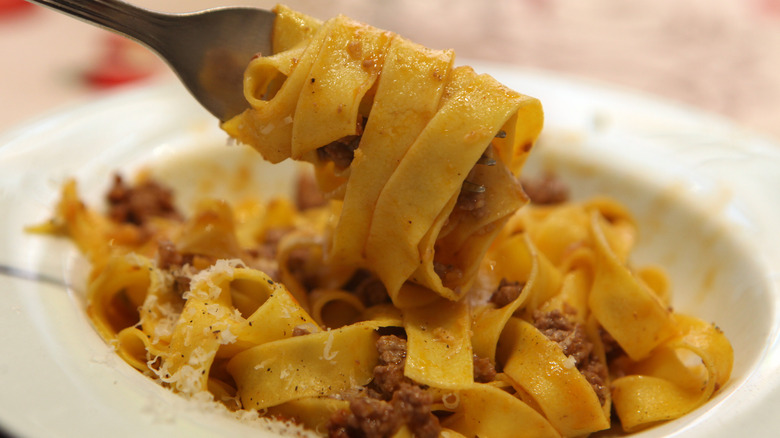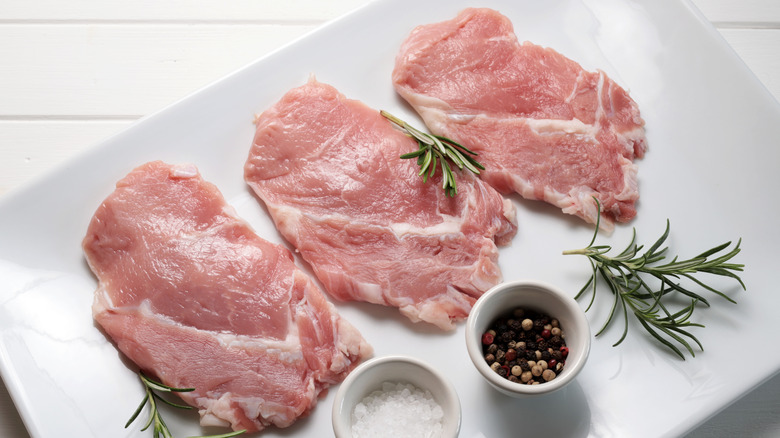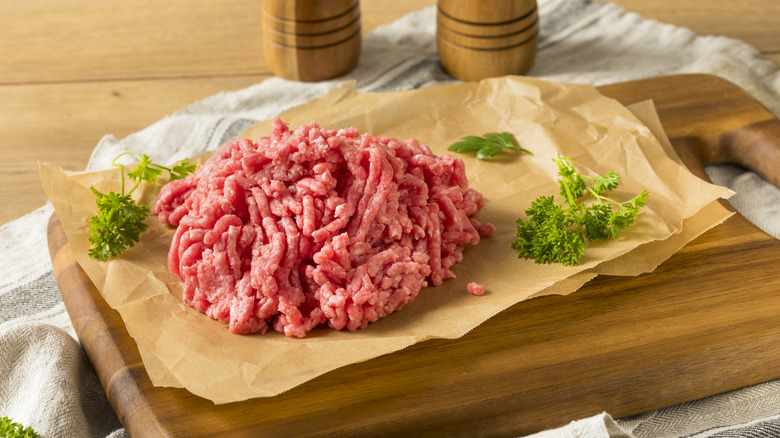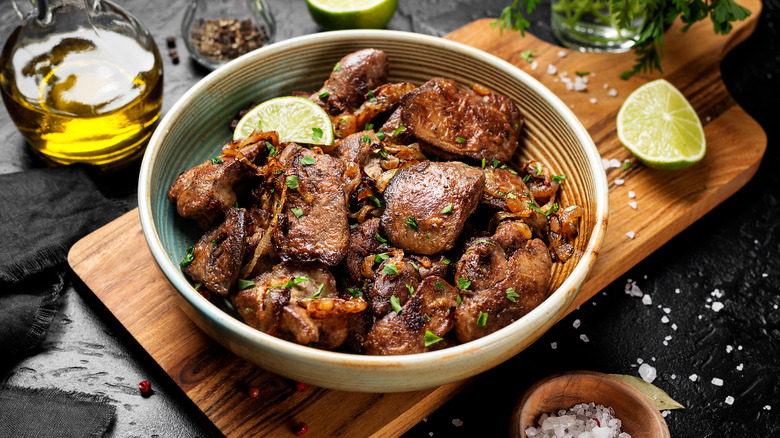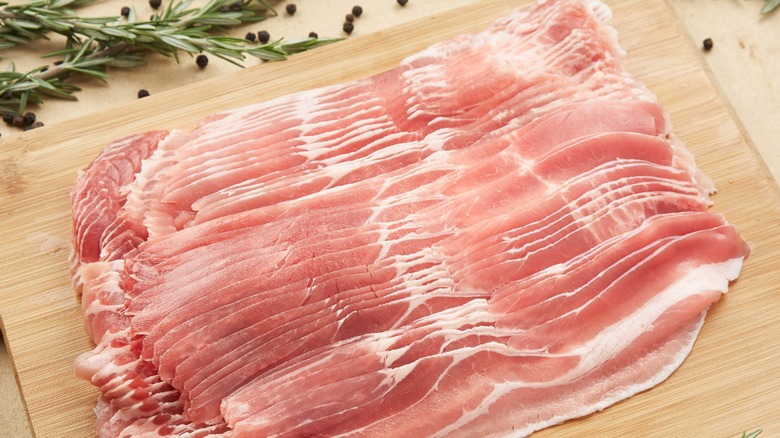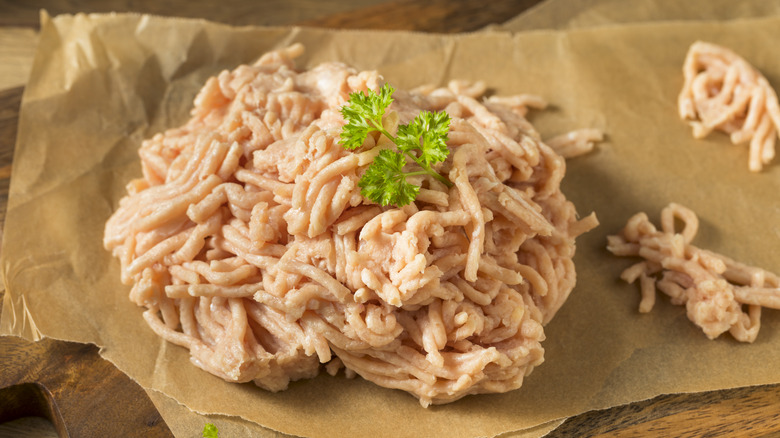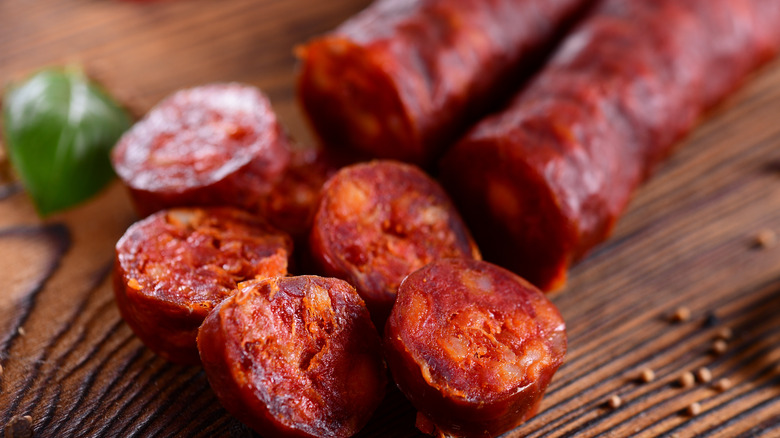7 Meats Sure To Amp Up Your Next Bolognese
A bolognese ragu is one of the most traditional sauces in Italian cuisine. From France to Italy, to the U.K. and United States, the bolognese is a go-to and crowd pleaser for home cooks and restaurant chefs. There are multiple ingredients that make a bolognese distinct, but one way to make yours stand out is by using different meats. But which meats are best for bolognese and which ones should you use to amp up your next recipe?
A traditional bolognese is a tomato-based sauce served over pasta that typically includes ground meat as its primary source of fat and flavor. This sauce will simmer anywhere from a few hours to an entire day in order for all its components to reduce in harmony. Usually, it will also include onion, celery, carrots, and wine to add acidity.
While you can typically find the sauce made with a combination of beef and pork, there are many other proteins that chefs have found take a bolognese to the next level. Some of these act as substitutes, while others are meant to add another dimension of flavor in addition to the basic ingredients. Going beyond ground beef and expanding your horizons to including more daring meats could be the key to making your next great bolognese.
Veal
In the grand scheme of things, veal has been a fairly popular meat choice throughout the history of European cooking, specifically in French and Italian food. You don't have to go that far back to find a time where veal, beef, and pork were among the most popular of meats you would put in meatloaf and other meat dishes — such as a bolognese sauce. Recently, though, it has become rarer to find veal on menus and sold in supermarkets. The question of whether Veal is okay to eat or not has been a hot button issue for chefs and foodies.
Veal is defined as a male calf under 18 weeks old. This cut of beef is controversial in the United States for a number of reasons, namely the treatment of the animals. Recently, farmers have won more humane conditions for veal calves and have tried to reinvent the image of veal as an ethical and affordable option. The price and availability of veal will vary depending on where you live, but if you can find it, this tender meat makes an excellent addition and contrast to the fatty ground pork many recipes call for as well.
Lamb
Worldwide, lamb is a fairly common meat that is served in a variety of cuisines. You know, it's not a shepherd's pie without the lamb. However, Americans are by and large pretty averse to lamb for sociological reasons that stretch back hundreds of years. But, as it turns out, this fatty meat makes a great bolognese, according to some professional chefs.
Peter Scaturro, executive chef of long-time Las Vegas Italian institution Trevi, opts for lamb in his bolognese recipe for the restaurant. His method of making lamb bolognese requires roasting two lamb shanks before even starting the day-long process that is making a bolognese. The longevity of the restaurant can speak to what the lamb brings to the dish.
If you've never eaten lamb and are curious to try it, making a bolognese is a tasty and safe place to start. You can include it as your only meat to give your traditional bolognese recipe a bold and unique flavor. Or you can try and adjust your flavors to suit the protein better, like in this recipe for Lamb Harissa Bolognese pasta.
Chicken livers
This bolognese upgrade might come as an initial shock to you or even sound unpleasant. In reality, adding chicken livers as an additional protein brings a special richness to the sauce you cannot get with anything else. Knowing how to incorporate chicken livers into your bolognese can be a game changer next time you are hosting dinner.
Liver adds flavor and depth to the already rich and delicious sauce. Many professionals recommend adding chicken livers to your bolognese, including Australian chef and Bake-Off host Maggie Beer. The chef revealed on Instagram that this bit of chicken offal is her secret ingredient to a perfect spaghetti bolognese. If you know this dish by the name Spag Bol you are in for a treat with Beer's recipe.
Beer begins by cooking up the livers alongside her onions and garlic before removing them. At the end, the chef adds them back in to mix with the final sauce at the end, before serving it all over a plate of spaghetti. It doesn't get more traditional than that. While your guests might ask what the secret ingredient that made the night's pasta so good is, they will never be able to guess it.
Bacon or Pancetta
Sure, you can just put bacon on most things and it will probably amp up that salty and smoky flavor and likely make whatever you're eating better. But there is a special argument for adding this delicious and fatty pork product into your next bolognese recipe. It adds a hamminess and pork flavor that some would call essential to the bolognese, but it comes down to taste at the end of the day. However, if you are not already adding ground pork and you have some bacon on hand, it won't hurt to throw it in the next time you cook this sauce on a lazy Sunday.
You can't go wrong with any cut of bacon in bolognese. It is a key ingredient in the apparently mind-blowing bolognese that actor Tom Hiddleston makes. While it's a fairly traditional recipe over all, Hiddleston adds bacon which makes all the difference. The actor served the dish to GQ writer Taffy Brodesser-Akner who said it was amazing and urged readers to "try Tom Hiddleston's Bolognese before you continue to talk about great Bologneses you've had in your life."
Much like bacon, pancetta can accentuate the other meats and flavors in your bolognese. This cured meat is also from the pork belly and is quite similar to bacon. Iron Chef Marc Forgione uses pancetta in his bolognese, but also includes mortadella and prosciutto for even more intense pork flavor.
Turkey
While it doesn't have a reputation for being as flavorful as beef, turkey is often viewed as a healthy alternative. This is true in a sense, and when it comes down to it turkey is lower in calories and saturated fats.Ground turkey is often used to cut down on red meat while still making a classic like a burger — or in this case bolognese. Taking turkey and substituting it for your traditional bolognese base won't make as much of a difference in flavor as you might fear. The meat will still take on the flavor of the aromatics, and sweetness and acidity from the wine and tomatoes, making for a balanced sauce nonetheless.
Turkey doesn't have to be ground turkey from the grocery store either, for it to work in your Sunday ragu. If you have leftover scraps from a whole bird or turkey breast from Thanksgiving, you can throw that in a food processor and grind that up. It won't replicate a beef or pork bolognese, but the turkey bolognese is a refreshing and different take on the dish. It is technically healthier in some ways, but still fits the bill of being a warm comforting sauce to smother your favorite pasta in.
Chorizo
At this point, we've established that most any pork product will go well in a bolognese — given that it can properly cook down with the rest of the sauce. If you're more familiar with Spanish and Mexican food, your mind might have already wandered to the spicy cousin of ground pork. Chorizo is a ground mixture of pork that is fully cooked and cured. Adding it to your next bolognese will add a new dimension of heat to this classic pasta dish. And depending on how intense you want the flavor to be, you can incorporate as much or as little chorizo as you want into the sauce and still make a difference.
Swapping in chorizo as one of the two or three meats you are using to make this dish will be enough to give it the extra kick you are looking for. Instead of regular ground pork, try spicing it up with chorizo in a one-to-one ratio with the beef. Or better yet, try replacing the ground beef with chorizo entirely and using that as your only meat. This is also a splendid option that will turn out deliciously.
Italian sausage
Some bolognese recipes add Italian sausage as a third meat in addition to the beef and pork to add a more herbaceous and flavorful element. Like Chorizo, Italian sausage can come in many forms, but typically these sausages are made either served whole in the casing, or ground up out of them. In or out of the casing can make a huge difference as to where this herb and spice flavored pork product can be used.
When it comes to bolognese, you are going to want to start with your Italian sausages out of the casing, since it is going to get ground up with the other meat and veggies in your sauce. The recipe used at Michelin-starred NYC restaurant Carbone insists you use equal parts beef, pork, and Italian sausage in order to elevate your bolognese. This addition is just one of many ways you can buff up your usual bolognese recipe with a burst of flavor that will permeate every single bite.
